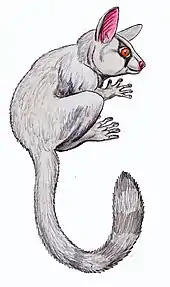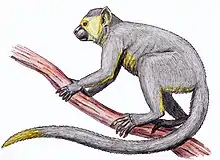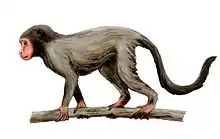| Chilecebus | |
|---|---|
| Scientific classification | |
| Domain: | Eukaryota |
| Kingdom: | Animalia |
| Phylum: | Chordata |
| Class: | Mammalia |
| Order: | Primates |
| Suborder: | Haplorhini |
| Infraorder: | Simiiformes |
| Family: | Atelidae |
| Genus: | †Chilecebus |
| Species: | †C. carrascoensis |
| Binomial name | |
| †Chilecebus carrascoensis Flynn, Wyss, Charrier and Swisher, 1995[1] | |
Chilecebus is an extinct genus of New World monkeys that lived in what is now Chile (Abanico Formation) during the Early Miocene some 20 million years ago. The type species is C. carrascoensis.[2] It had a body mass of about 1,000 g (35 oz).[3]
See also
References
- ↑ Flynn, J.; et al. (16 February 1995). "An Early Miocene anthropoid skull from the Chilean Andes". Nature. 373 (6515): 603–607. Bibcode:1995Natur.373..603F. doi:10.1038/373603a0. PMID 7854415. S2CID 1537837.
- ↑ Chilecebus at Fossilworks.org
- ↑ Silvestro, Daniele; Tejedor, Marcelo F.; Serrano Serrano, Martha L.; Loiseau, Oriane; Rossier, Victor; Rolland, Jonathan; Zizka, Alexander; Antonelli, Alexandre; Salamin, Nicolas (2017). "Evolutionary history of New World monkeys revealed by molecular and fossil data" (PDF). BioRxiv. _: 1–32. Retrieved 2019-02-20.
This article is issued from Wikipedia. The text is licensed under Creative Commons - Attribution - Sharealike. Additional terms may apply for the media files.



